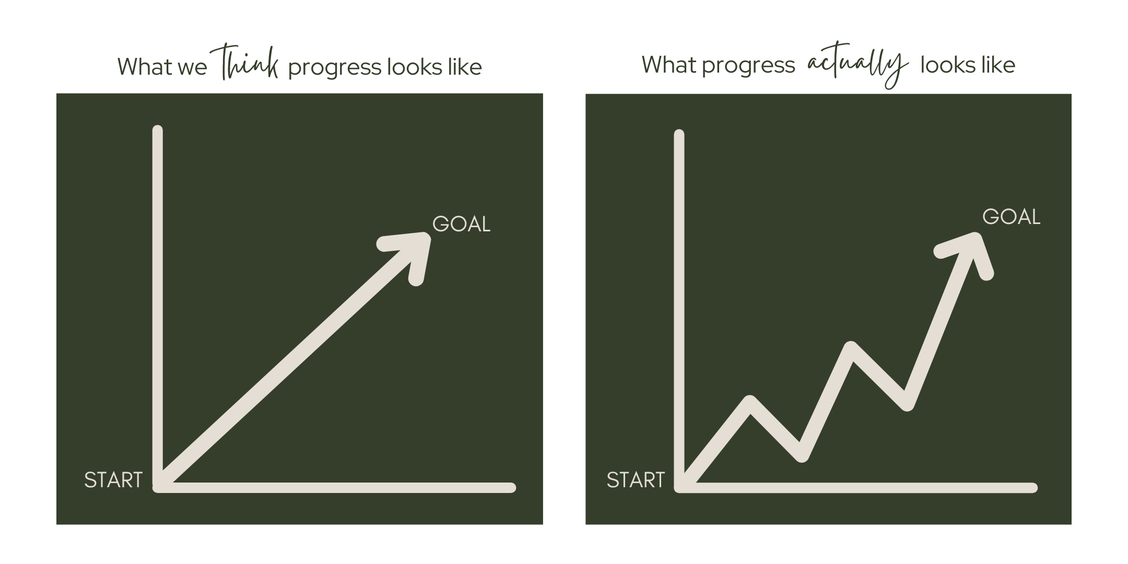Healing Isn’t a Straight Line
How to Navigate Recovery Setbacks
Are you recovering from an injury and suddenly experiencing more pain? You’re not alone. Many people expect a smooth recovery, only to be surprised by setbacks, flare-ups, or pain that seems worse than before. But here’s the truth: healing isn’t linear.
Why do setbacks happen during injury recovery?
Some of the most common setbacks I see with patients on their healing journey include:
Too much, too soon
All-or-nothing
Belief that pain equals damage
Mismatched expectations
Too much, too soon
Simply put, pushing too hard can slow your recovery process.
Very often as your pain decreases and your movement improves, so does your confidence.
With increased confidence, you get back into activity, but return at a level (intensity, duration, or frequency) that your body and your tissues (bone, muscle, tendon, ligament) or nervous system aren’t ready for yet.
When you overreach, you end up in a boom-bust cycle. You do too much, too soon and end up with pain again.
This cycle often leads to frustration, a desire to push through adopting the “no pain, no gain” mentality, or, in some cases, results in fear and avoidance of movement.
All-or-nothing
The problem with an all-or-nothing approach to healing is that it can result in avoiding returning to activity until you think you’re able to go all in.
But, if you don’t give yourself a chance to build up your tissue (bone, joint, muscle, tendon, ligament) and nervous system capacity to handle the stresses of your chosen activity, you’ll very often end up with a setback.
For a lot of runners I work with, this shows up as avoiding running completely due to pain or injury and then expecting to be able to return to their prior “short” run (usually 2 or more miles) without building up to it.
When we look at this “short” run and consider each step as a repetition, that’s a lot of reps! And they have not appropriately conditioned their body to return to this load.
When we can take a more gradual, graded approach to return to activity using run-walk intervals with specific guidelines for progression, we give our body time to adapt to the load and can progress with fewer set-backs.
Belief that pain equals injury
Maybe you’ve wondered, does pain mean I’ve injured myself?
While pain is an important signal to pay attention to - it’s literally your nervous system and brain's way of getting your attention - it doesn’t always mean you have an injury or tissue damage.
When it comes to pain, we often need to zoom out and look at what’s happening in all areas of life.
One way to do this is utilizing the Threat Bucket, creating awareness of what threats or stressors you are experiencing and how that’s impacting your pain, overwhelm, fatigue, or poor performance. If you want to learn more about the Threat Bucket, check out my post What is a Threat Bucket? Understanding the Connection Between Stress and Pain
Maybe you can recall a time when you’ve had the flu and been forced to lie around for a few days. Usually at some point you start to feel some aches and pains in your body, but you haven’t had an injury.
Simply, your system is overloaded and the lack of movement contributes to your experience of pain, signaling your brain to do something about it - change your position, try some light movement, hydrate, make sure you’re nourishing your body, etc.
In short, pain does not always equal injury.
Mismatched expectations
In the injury recovery process, I think it’s important to set realistic expectations.
Maybe you expected a straight line from the start of healing to pain-free activity.
If so, it makes sense that a setback feels devastating.
But, the reality is, just like working toward any goal in life, the healing process is not linear and there will be ups and downs along the way.
In fact, as much as it sucks, I think these setbacks or flare-ups can be a positive.
Let me explain.
If you were in pain or afraid of moving your body, you never would have even tried getting back into activity.
The fact that you felt confident enough to do activity without hesitation means you’re on the right track.
Even though your body wasn’t quite ready for the level of activity you did and you experienced a setback, you already have evidence that your body is resilient, that it will heal, and you can trust that you’ll be able to get back to feeling better.
As a bonus, you have more information than you did before!
You now know what “too much” is at this moment in your healing process and you can make corrections to take smaller steps as you return to activity.
How to Navigate Pain Flare-Ups Without Fear
Here are a few actionable tips you might try when you experience a setback or flare-up of pain and the frustration + fear that comes with that:
Remind yourself that your body is resilient and that your pain improved once already so you can trust that it will again
Move your body gently in ways that feel good and create feelings of safety
Breathe - full, deep breaths all the way into your belly with a long, slow exhale to help calm your nervous system
If you don’t have an appointment already scheduled, get yourself back into physical therapy so you can receive the support you need to navigate your flare-up
You don’t have to navigate your recovery alone.
If you’re struggling with pain, setbacks, or uncertainty about your next steps, I can help. Book a physical therapy session to get personalized support and a clear plan to move forward with confidence.
Disclaimer: this post is intended for informational purposes only and is not medical advice. If you are experiencing pain, it is always in your best interest to consult with your medical doctor and/or your physical therapist.


